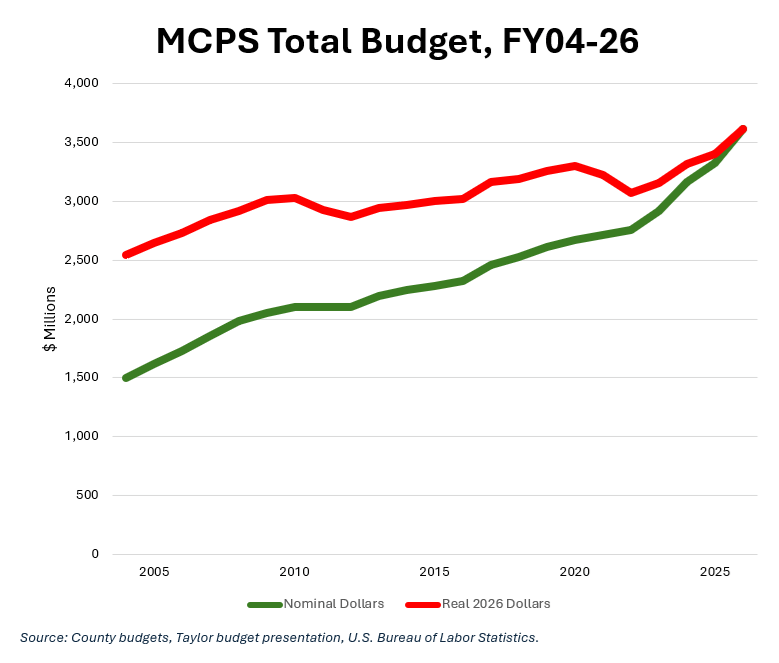By Adam Pagnucco.
Last night, Superintendent Thomas Taylor announced the broad terms of his recommended budget. As I am writing this column (on Wednesday night), I don’t have a copy of his budget, so I can’t analyze it. All I have is the slides he showed in his live stream. But those slides will suffice for an early look at one of the most critical aspects of his budget: the colossal size of his ask.
First, a note about Taylor. He is a good communicator. He speaks in plain English. He links numbers to values, policies and students. He also has a sense of humor. (Don’t bring up broccoli with him; offer him popcorn instead.) If he were a university lecturer, he would be one of the best. I watched every minute of his hour-long presentation of his recommended budget and none of it was boring.
Taylor will need every iota of his communication skills to get his budget financed because his ask is by far the largest in the last two decades of MCPS’s history.
The slide below shows his requested increase by type of financing for MCPS. His total ask is an additional $296 million. Of that amount, $285 million is due from county taxpayers.

MCPS is a gigantic organization, so any of its numbers will be big. That said, what does an increase of $285-296 million really mean? Let’s look at the last two decades of MCPS’s budget history.
The chart below shows the county’s appropriation to MCPS from FY04 through FY26. The green line shows nominal dollars which have not been adjusted for inflation. The red line shows the same data in 2026 dollars, using the Washington-Arlington-Alexandria CPI-U and assuming the inflation rate in 2025 and 2026 as the average of the prior ten years (2.4%).

The green line (nominal dollars) shows a steady increase to MCPS with an interruption during the Great Recession. But the red line, which accounts for inflation, shows decreases during both the Great Recession and the pandemic. We will discuss that more soon.
This chart shows the annual increases in the county’s appropriation to MCPS. Again, the green line is in nominal dollars and the red line is in real (inflation-adjusted) dollars.

In both nominal dollars and real dollars, Taylor’s ask dwarfs any increase that MCPS has received in more than twenty years. But two other things stand out in this chart.
First, the county implemented large cuts in its contribution to MCPS during the Great Recession. Taylor alluded to this when he discussed how his budget “filled holes” that were created long ago. He is not wrong about this: during the recession, the county cut its per pupil contribution to MCPS three years in a row and then froze it for four years in a row. That created fiscal challenges that Taylor’s predecessors had to confront, although they obtained sizeable budget increases in FY17, FY24 and FY25.
Second, the real dollar declines in FY21 and FY22 are not due to nominal dollar cuts by the county but rather to price inflation rates of 4.0% in 2021 and 6.6% in 2022. In those two years, the county’s small increases to MCPS were overwhelmed by unusually high pandemic-era inflation.
Now let’s look at MCPS’s total budget over the same period. While the county appropriation accounts for more than 60% of MCPS’s budget, the district does receive substantial funds from the state and federal governments as well as internally generated revenues. As with the above charts, the green line shows nominal dollars and the red line shows real 2026 dollars (adjusted for inflation).

As with the county appropriation, the green line shows steady increases but the red line, which includes inflation, shows troughs during the Great Recession and the pandemic.
This chart shows the annual increases to MCPS’s total budget.

The story with total dollars is similar to nominal dollars: Taylor’s ask is by far the largest in more than twenty years. However, MCPS’s total budget was challenged by cuts during the Great Recession and inflation during the pandemic. Those are the holes Taylor is talking about.
I will give Taylor credit for this: he knows he is making a big ask as this slide from his presentation demonstrates.

One last item of context. As of two years ago, a one percent increase in the property tax rate yielded roughly $22 million in revenue. If one assumes a slight increase in yield due to rising assessments, that means Taylor’s local dollar ask would require the equivalent of a 12% property tax hike to finance. That assumes no growth in the rest of the government. Yes, there is usually regular growth in income and property tax collections and the county has recently revised its revenue projections upwards. (The reason is that the county has been incorrectly assuming a recession in its last few revenue forecasts, a troubling topic about which I will have more to say soon.)
But connect these dots and Taylor’s huge ask – justified or not – could set off one of the biggest tax fights in recent county history. The stakes involve the future of MCPS, the condition of the county’s economy and the election of the next county executive.
